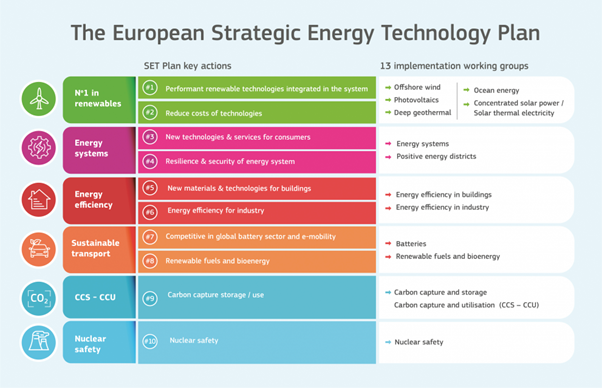The European Strategic Energy Technology Plan (SET Plan) promotes and coordinates research and innovation efforts across Europe and supports the most impactful technologies for the transformation to a climate-neutral energy system. The goal is to accelerate the development and deployment of low-cost, low-carbon technologies.
To this end the SET-Plan brings all relevant stakeholders together. These include representatives from the EU Member States, the European Energy Research Alliance (EERA), and the European Technology and Innovation platforms (ETIPs). The ETIPs will provide industry-driven recommendation on how to support technology improvements and bring down costs.
The SET-Plan identifies 10 key actions for research and innovation. These are based on the future energy system needs, the transformational impact of technologies, and their potential to create economic growth and provide jobs in the EU. The SET-Plan addresses the whole innovation chain, from research to market uptake, and tackles both financing and the regulatory framework.

The first two key action are on global leadership in renewables. Five renewable energy technologies, including offshore wind, are highlighted to particularly benefit from pan-European collaboration. For each technology a dedicated Implementation Working Group has been established.
The Implementation Working Groups will enable, promote, facilitate, and monitor the execution of pre-defined Research & Innovation activities. Private stakeholders, industry and research organisations participate in the Implementation Working Groups and the Research & Innovation activities via the ETIPs and EERA. The outcomes are published in annual SET-Plan progress reports.
Implementation Working Group on Wind energy (IWG Wind)
In 2016 Representatives from the Netherlands and ETIPWind co-chaired a group of EU Member states representatives, sector stakeholders and the European Commission to define concrete Research & Innovation actions to accelerate deployment of Offshore wind in Europe and to propose relevant funding opportunities for their realisation. The result was the first Implementation Plan on Offshore Wind, which was formally adopted in 2018.
The 2018 report included two cost-driven targets:
- Reduce the levelised cost of energy (LCoE) at final investment decision (FID) for fixed offshore wind by improvement of the performances of the entire value chain to less than 10 ct€/kWh by 2020 and to less than 7ct€/kWh by 2030.
- Develop cost competitive integrated wind energy systems including substructures which can be used in deeper waters (>50m) at a maximum distance of 50 km from shore with a LCoE* of:
- less than 12 ct€/kWh by 2025 and to
- less than 9 ct€/kWh by 2030, striving towards cost competitiveness.
Europe’s strengthened energy and climate ambitions for 2030 and 2050 and the fast development within the offshore wind energy sector require to the Implementation Plan to be updated. The new plan is written by the Implementation Working Group, with the support of the SETWIND project. The new plan will focus primarily on accelerating deployment which in turn will lead to cost reductions. The new proposed targets are:
- Achieve 8.7 GW annual installed capacity by 2030.
- Achieve 21.4 GW annual installed grid capacity by 2050.
- Reach an average levelized cost of energy (LCOE) of between 35 and 45 €/MWh by 2030 for bottom-fixed offshore wind.
- Reach an average LCOE of between 62 and 106 €/MWh by 2030 for floating offshore wind.
For further information, see:
2018 Implementation Plan on offshore wind
